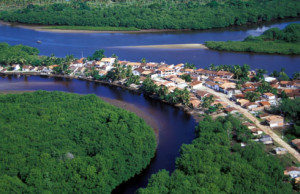English
 The award-winning project Brasil das Águas used innovative technology installed in an amphibian aircraft to collect water samples in 2003/2004 from 1,160 sample locations scattered all over Brazil. The analyses of these samples made it possible to compose a panorama of the quality of Brazil’s fresh water reserves (See map of the results in Portuguese). The main objective of the project was to produce results that would increase awareness amongst the general population and actively involve everyone in the preservation of the country’s water resources.
The award-winning project Brasil das Águas used innovative technology installed in an amphibian aircraft to collect water samples in 2003/2004 from 1,160 sample locations scattered all over Brazil. The analyses of these samples made it possible to compose a panorama of the quality of Brazil’s fresh water reserves (See map of the results in Portuguese). The main objective of the project was to produce results that would increase awareness amongst the general population and actively involve everyone in the preservation of the country’s water resources.
As a natural sequence to the ‘mother project’, “Seven Rivers” continued, in 2006 and 2007, with its aim to involve those who live along the riverbanks in protecting their rivers. Once again leading this new development, pilot and engineer Gérard Moss and his wife Margi, together with other team members, travelled the length of seven rivers selected from different regions of the country.
Based on information gathered in the previous phase of the project and on newly-taken aerial images, the team again collected new samples all along the rivers, and made public presentations in the main towns along the route to show local people what their river looks like up or down stream. Listening to the feelings of those who inhabit its banks made it easier to understand how each community regards its river and thus determine the best way to mobilize them into taking measures to protect their resources.
Each of the seven campaigns aimed to identify the main risks threatening the selected rivers. Aspects such as irregular occupation of riverbanks, intensive use of fertilizers or weed-killers, soil management and erosion, the state of the riverine forest, sewage treatment, discharge of effluents and proximity of waste dumps were catalogued. Just as importantly, there was a chance to identify new opportunities for sustainable development, such as the tourism potential in areas like trekking, canoeing, rafting, bird-watching and sports fishing. All this information served as a base for encouraging new conservation programmes with the input and participation of local authorities and NGOs, always taking the social, economic and environmental situation of each specific region into consideration. With the exception of the Araguaia River, the Brasil das Águas team’s own personal choice, the other six rivers were selected by a panel of scientists and water resource experts at a workshop held in Brasilia. They were the Grande (in Bahia state), Ribeira do Iguape (Paraná and São Paulo states), Ibicuí (Rio Grande do Sul), Miranda (Mato Grosso do Sul), Verde (Mato Grosso) and Guaporé (forms the border with Bolivia in Mato Grosso and Rondonia) rivers. The first three expeditions were completed in 2006 and the remaining four in 2007.


